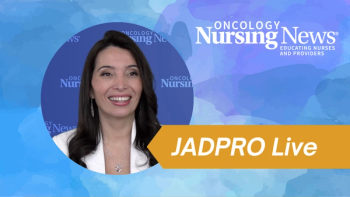
Immunotherapy Only Gets Better in NSCLC
Immunotherapy continues to improve upon the treatment of non-small cell lung cancer, and there are more exciting advancements on the horizon.
Improving upon the widespread benefit of single-agent and combination immunotherapy by determining optimal patient selection and introducing combinations targeted toward novel pathways, such as TIGIT, has the potential to further the field of advanced non–small cell lung cancer (NSCLC), explained Davey B. Daniel, MD.
“Immunotherapy following chemotherapy is the standard of care, but there are questions that we need to answer,” said Daniel. “Although we have several options for chemotherapy plus immunotherapy, we don’t have a clear winner. We know that we can improve upon immunotherapy alone, and there are a number of interesting trials out there that may help us understand that.”
During a 2020 OncLive® Institutional Perspectives in Cancer webinar on lung cancer, Daniel, a medical oncologist at Tennessee Oncology, discussed key immunotherapy trials in advanced NSCLC and explained how the results can be extrapolated to clinical practice.
PACIFIC Trial Continues to Demonstrate Benefit With Single-Agent Durvalumab
Updated data from the phase 3 PACIFIC trial, which were presented during the 2020 ESMO Virtual Congress, showed that durvalumab (Imfinzi) continued to provide meaningful overall survival (OS) and progression-free survival (PFS) benefit at 4 years compared with placebo after concurrent chemoradiotherapy in patients with unresectable stage III NSCLC.1
Patients in the PACIFIC trial were randomized 2:1 to receive 10 mg/kg of durvalumab every 2 weeks for up to 12 months (n = 476) or placebo every 2 weeks for up to 12 months (n = 237).
In the intention-to-treat (ITT) population, the median 4-year OS was 47.5 months with durvalumab compared with 29.1 months with placebo (stratified HR, 0.71; 95% CI, 0.57-0.88). The 4-year median PFS was 17.2 months versus 5.6 months, respectively (stratified HR, 0.55; 95% CI, 0.44-0.67).
“Historically, I would have told [patients that only about one-quarter of patients are cured. Now, with 4-year survival of almost 50%, it is really reassuring,” said Daniel.
Notably, all subpopulations, irrespective of sex, age at randomization, smoking status, NSCLC disease stage, tumor histologic type, prior definitive chemotherapy, and best response to prior therapy (complete response was not applicable), favored durvalumab versus placebo with regard to OS and PFS.
Post-hoc analyses revealed that patients with PD-L1 expression between 1% and 24% and 1% or greater would derive an OS survival benefit from durvalumab versus placebo. Patients with PD-L1 expression of less than 1% would not derive an OS benefit from durvalumab but would derive a PFS benefit.
Additionally, a recent publication in Lung Cancer demonstrated improved OS and PFS with durvalumab versus placebo irrespective of prior chemotherapy (platinum and non-platinum) and radiation.2
“We are not going to repeat this type of trial again. The control arm is always going to be immunotherapy [rather than] a placebo, so it is important to glean as much information as possible from these results,” explained Daniel.
Remaining questions regarding the PACIFIC trial include whether some patients should have received surgery, the overall benefit that patients with stage IIIA versus stage IIIB disease can derive from durvalumab, and the role of sensitizing mutations, particularly EGFR, in this treatment regimen. The ongoing phase 3 LAURA trial (NCT03521154) may provide some insight into the latter question by assessing the effects of osimertinib (Tagrisso) following chemoradiation in patients with unresectable stage III NSCLC, Daniel said.
Novel Chemoimmunotherapy Regimen Emerges From the CheckMate-9LA Study
In May 2020, the combination of nivolumab (Opdivo) and ipilimumab (Yervoy) plus 2 cycles of platinum-doublet chemotherapy was approved by the FDA for the up-front treatment of patients with metastatic or recurrent NSCLC who do not harbor EGFR or ALK mutations.3
CheckMate-9LA, the trial for which the regulatory decision was based on, randomized patients 1:1 to receive 360 mg of nivolumab every 3 weeks plus 1 mg/kg of ipilimumab every 6 weeks with chemotherapy every 3 weeks for 2 cycles (n = 361) versus chemotherapy every 3 weeks for 4 cycles with optional pemetrexed maintenance (n = 358).4
“CheckMate-9LA was designed to overcome that dip in the survival curve that we saw in many of the prior immunotherapy trials,” said Daniel. “The thought was that the chemotherapy backbone would decrease the tumor volume and prevent hyperprogression while allowing the immunotherapy to [elicit] a long-standing, durable response we all hope for.”
Findings from the CheckMate-9LA trial, which were presented during the 2020 ASCO Virtual Scientific Program, showed that the median OS was 15.6 months with chemoimmunotherapy versus 10.9 months with chemotherapy alone (HR, 0.66; 95% CI, 0.55-0.80). The 12-months OS rates were 63% and 47%, respectively.
Additionally, the median PFS was 6.7 months with the chemoimmunotherapy combination versus 5.0 months with chemotherapy alone (HR, 0.68; 95% CI, 0.57-0.82). The 12-month PFS rates were 33% and 18%, respectively.
Patients with squamous and nonsquamous histologies benefitted from the chemoimmunotherapy regimen; however, patients with adenocarcinoma derived slightly more benefit, potentially due to the addition of maintenance pemetrexed, said Daniel. Moreover, across all PD-L1–expression subgroups, the chemoimmunotherapy regimen performed better versus chemotherapy alone.
“I care about where the tail continues to plateau in immunotherapy trials. CheckMate-9LA doesn’t have enough [follow up] to compare it with other [immunotherapy trials],” said Daniel. “The decision isn’t clear as to which [chemoimmunotherapy regimen] to choose, but this is another option.”
Anti-TIGIT Therapy Shows Promise in the CITYSCAPE Trial
“We know that immunotherapy alone with a PD-1/PD-L1 agent is attractive, but can we improve those outcomes?” Daniel asked. “The TIGIT pathway is likely [as] important as other checkpoint pathway proteins are. In early preclinical data, there [appears to be] synergistic activity between [TIGIT] and PD-L1 [inhibitors].”
The phase 2 CITYSCAPE trial randomized patients with EGFR/ALK wild-type NSCLC with a PD-L1 tumor proportion score (TPS) of 1% or greater to 600 mg of intravenous (IV) tiragolumab plus 1200 mg of IV atezolizumab (Tecentriq), both every 3 weeks, or placebo plus atezolizumab.5
Initial findings from the study, which were presented during the 2020 ASCO Virtual Scientific Program, showed an overall response rate (ORR) of 37% with tiragolumab/atezolizumab (n = 67) versus 21% with placebo/atezolizumab (n = 68) in the ITT population. Patients with PD-L1 TPS status of 50% or more had an ORR of 66% with tiragolumab versus 24% with placebo. Patients with PD-L1 TPS status between 1% and 49% had ORRs of 16% and 18%, respectively.
The median PFS in the ITT population was 5.55 months in the tiragolumab-containing arm versus 3.88 months with placebo (HR, 0.58; 95% CI, 0.38-0.89). The median PFS was not reached in patients with high PD-L1 expression who received tiragolumab versus 4.11 months with placebo (HR, 0.30; 95% CI, 0.15-0.61).
Notably, in January 2021, the FDA granted a breakthrough therapy designation to tiragolumab plus atezolizumab for the frontline treatment of patients with metastatic NSCLC whose tumors highly express PD-L1 and are EGFR/ALK negative.6 Moreover, the confirmatory phase 3 SKYSCRAPER-01 trial (NCT04294810) is evaluating the anti-TIGIT antibody plus atezolizumab versus placebo/atezolizumab in treatment-naïve patients with locally advanced, unresectable or metastatic, PD-L1–selected NSCLC.7
References
1. Faivre-Finn C, Vincente D, Kurata T, et al. Durvalumab after chemoradiotherapy in stage III NSCLC: 4-year survival update from the phase III PACIFIC trial. Ann Oncol. 2020;31(suppl 4):S1178-S1179. doi:10.1016/j.annonc.2020.08.2281
2. Faivre-Finn C, Spigel DR, Senan S, et al. Impact of prior chemoradiotherapy-related variables on outcomes with durvalumab in unresectable stage III NSCLC (PACIFIC). Lung Cancer. 2021;151:30-38. doi:10.1016/j.lungcan.2020.11.024
3. U.S. Food and Drug Administration approves Opdivo (nivolumab) + Yervoy (ipilimumab) combined with limited chemotherapy as first-line treatment of metastatic or recurrent non-small cell lung cancer. Published May 26, 2020. Accessed January 19, 2021. https://bit.ly/2yxso7U
4. Reck M, Ciuleanu TE, Cobo Dols M, et al. Nivolumab (NIVO) + ipilimumab (IPI) + 2 cycles of platinum-doublet chemotherapy (chemo) vs 4 cycles chemo as first-line (1L) treatment (tx) for stage IV/recurrent non-small cell lung cancer (NSCLC): CheckMate 9LA. J Clin Oncol. 2020;38(suppl 15)9501. doi:10.1200/JCO.2020.38.15_suppl.9501
5. Rodriguez-Abreu D, Johnson ML, Hussein MA, et al. Primary analysis of a randomized, double-blind, phase II study of the anti-TIGIT antibody tiragolumab (tira) plus atezolizumab (atezo) versus placebo plus atezo as first-line (1L) treatment in patients with PD-L1-selected NSCLC (CITYSCAPE). J Clin Oncol. 2020;38(suppl 15):9503. doi:10.1200/JCO.2020.38.15_suppl.9503
6. Roche’s novel anti-TIGIT tiragolumab granted FDA breakthrough therapy designation in combination with Tecentriq for PD-L1-high non-small cell lung cancer. News release. Roche. January 5, 2021. Accessed January 19, 2021. http://bit.ly/2LoNrj2
7. A study of tiragolumab in combination with atezolizumab compared with placebo in combination with atezolizumab in patients with previously untreated locally advanced unresectable or metastatic PD-L1-selected non-small cell lung cancer (SKYSCRAPER-01). ClinicalTrials.gov. Posted March 4, 2020. Updated December 31, 2020. http://bit.ly/2YaVCmx
This article was originally published on OncLive as, "


















































































